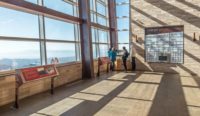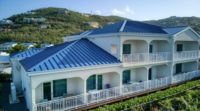Metal Roof Solar Project Survives Category 5 Hurricane Winds
.jpg?t=1718135446&width=1080)
.jpg?t=1718135473&width=1080)
.jpg?t=1718135446&width=150)
.jpg?t=1718135473&width=150)
Seven months after the devastation of Hurricane Otis to the resort city of Acapulco on the Pacific Coast of Mexico, this category 5 hurricane provided lessons for locals and businesses.
The metal roof solar project at Grupo Comercial Chedraui, one of the country’s leading grocery superstore chains operating nearly 350 stores throughout Mexico, sustained severe damage. However, the solar metal roof of its Acapulco store was one of the few that survived the onslaught of wind and rain, attributed to the clamp attachment securing the solar array to the roof, which provided a stronger attachment and may have saved the roof and the entire infrastructure.
Just one month before Hurricane Otis made landfall, solar EPC “Energía Real” completed the solar photovoltaic installation of 538 Trina Solar 545W modules for a total installed capacity of 293 kWp, on the store’s KR-18 sheet metal roof. These modules were secured to the roof using S-5!'s PVKIT®, the world’s first rail-less system for mounting solar to metal roofs, together with the S-5-MXTM Mini clamp, two 100 KW Huawei inverters and one 40 KW Huawei inverter providing 240 kWp of installed AC capacity.
The Hurricane
On October 25, 2023, Hurricane Otis made landfall near the port of Acapulco. Its power devastated the coast of Guerrero, with maximum sustained winds of about 270 kilometers per hour, one of the strongest recorded hurricanes to have impacted the Mexican Pacific.
The intensity that Otis acquired took climate scientists by surprise. The data from the surveillance systems did not anticipate the risk of a destructive force that would trigger the disaster in Acapulco and nearby towns, resulting in human and material losses.
The Devastation
While most of the surrounding shops, restaurants, hotels and businesses suffered considerable damage from the category 5 hurricane, remarkably and for the most part, the Chedraui store remained intact. In the aftermath of the hurricane, the roofing contractor visited the site to inspect for roof damage. Sections of the roof that were without solar experienced roof blow-off. However, the store’s rooftop solar array secured in place by the PVKITs and MX Mini clamps withstood the devastation.
Metal Roofing in High Wind Conditions
Metal roofing, in particular standing seam metal roofing, is known for its exceptional performance in high-wind conditions, due in part to its attachment methods and interlocking installation where roof panels are overlapped and attached to the structure of the building, reducing the ability of wind to disrupt the panels. Metal roofing lends itself to high-wind areas because it can be engineered easily to withstand nearly any uplift force within the design stage.
Observations
Photos of the site taken post-hurricane clearly indicate the vast majority of roof damage was to areas of the roof without solar installed. This is evident, even in the higher-pressure edge roof zones, where the roofing panels along the edge zones, under the solar modules, were not damaged while the nearby bare roofing was blown off. The logical conclusion is that the solar modules, PVKITs and MX Mini clamps installed over portions of the roof prevented those portions from failing, preserving both the solar modules and the roof.
The MX Mini clamps together with the PVKIT solar mountings by S-5! were installed to secure the solar modules to the metal roof, but the clamps performed a secondary function as wind clamps, often referred to as External Seam Clamps. These external seam clamps measurably increase the roof’s wind uplift resistance capacity, preventing multiple modes of failure, including seam separation and clip disengagement (when used at roof clip locations).
Third-party testing performed in 2013 resulted in a 300% increase in uplift resistance of a metal roof when S-5!’s WindClamps™ were installed on the roof seams. The MX Mini clamps on the Chedraui grocery store roof acted as external seam clamps during the Acapulco category 5 hurricane.
Considering how the wind causes uplift forces when approaching and blowing across the solar array installed on the roof, the dynamics of the wind forces shifted from direct pressure on the roof to split pressure on both the roof and the solar modules. The metal roof seams were strengthened from the installation of the clamps to resist uplift pressures on the roof and met the challenge to secure the solar modules to the building, preventing wind uplift forces from tearing them off the building and preserving the roof.
In this scenario, those uplift forces were transferred into the KR-18 roof through the PVKITs and MX Mini clamps, then from the roof panels to the roof clips and into the building structure. Together, these components and connections were strong enough to prevent the modules from disengaging from the roof panels and preventing the roof from pulling off the building’s structure.
Often, there is a concern that a metal roof panel, like the KR-18, is not strong enough to transmit the forces as part of the load path described above, or that the roof clips may be overloaded and fail from these discrete point loads. From observations in this case study, such concerns are not valid. All the components in the load path and all the connections between the components remained intact and connected, keeping the system together and undamaged, including the roof panels and roof clips. The roof below the solar modules clearly was not damaged or torn off.
Looking for a reprint of this article?
From high-res PDFs to custom plaques, order your copy today!



.jpg?height=200&t=1713956980&width=200)


.jpg)
.jpg)